
The Toshiba EMI Recordings / Original Stereo Version
16. The Beatles (A.K.A. White Album) (AP-8570/1)
(Update: 11th. August 2023)

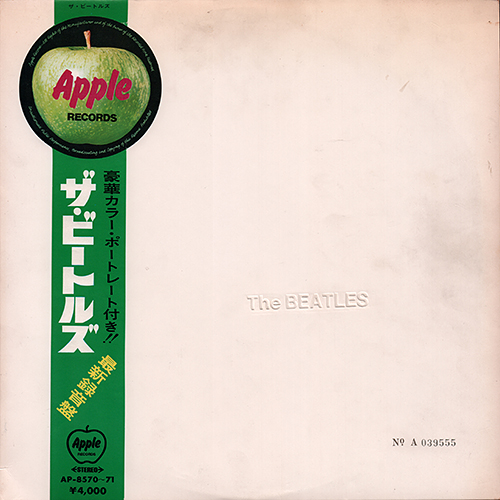 Apple 1st. Sleeve |
|
| TITLE | THE BEATLES |
||||
| CATALOG NUMBER | AP-8570/1 |
||||
| RELEASE DATE | Promotional
Record
(First Press: 18th.
January.1969) |
||||
| TRACK LISTING | SIDE 1 | SIDE 2 | |||
| Back In The U.S.S.R. |
Martha My Dear |
||||
| Dear Prudence |
I'm So Tired |
||||
| Glass Onion |
Blackbird | ||||
| Ob-La-Di, Ob-La-Da |
Piggies | ||||
| Wild Honey Pie |
Rocky Raccoon |
||||
| The Continuing
Story Of Bungalow Bill |
Don't Pass Me By |
||||
| Whie My Guitar Gentry Weeps |
Why Don't We Do
It In The Road |
||||
| Happiness Is A
Warm Gun |
I Will |
||||
| Julia |
|||||
| SIDE 3 |
SIDE 4 |
||||
| Birthday |
Revolution 1 |
||||
| Yer Blues |
Honey Pie |
||||
| Mother Nature's
Son |
Savoy Truffie |
||||
| Everybody Got
Something To Hide Execept
Me And My Monky |
Cry Baby Cry |
||||
| Sexy Sadie |
(" Can You Take
Me Back...") |
||||
| Helter Skelter |
Revolution 9 |
||||
| Long Long Long |
Good Night |
||||
| ALBUM COVER |
INNER
SLEEVE |
||||
| DISC1: FRONT | DISC1: BACK | DISC1: FRONT |
DISC1: BACK |
The
original plain white inner bag has a fold-over flap at the
top of the bag to prevent the record from falling out. With a die-cut circular opening on one side. |
|
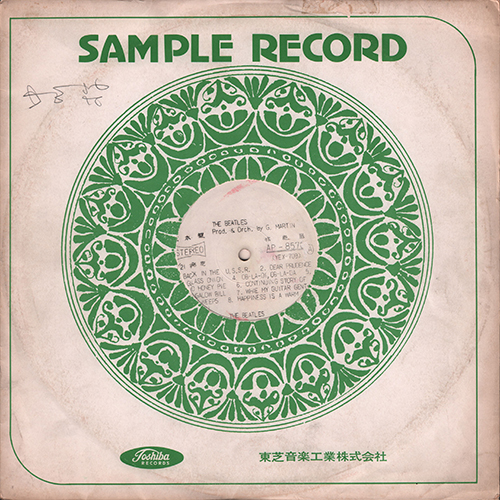 |
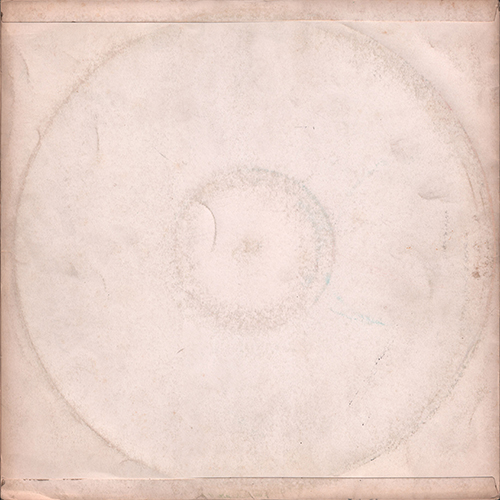 |
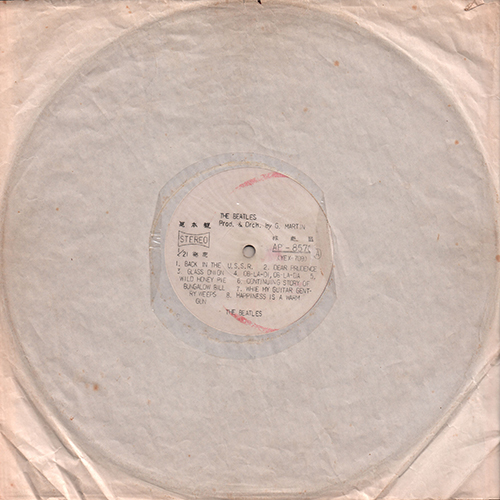 |
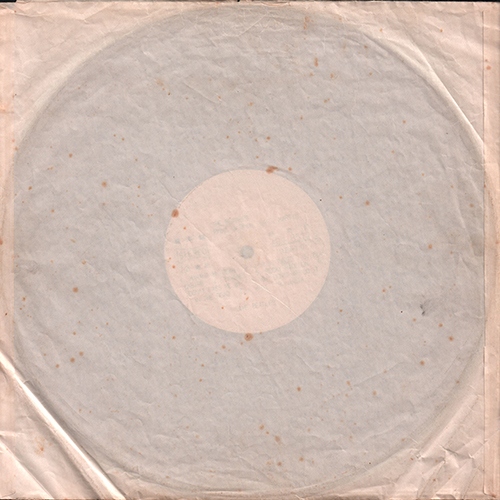 |
||
| DISC2: FRONT | DISC2: BACK | DISC2: FRONT | DISC2: BACK | ALBUM COVER | |
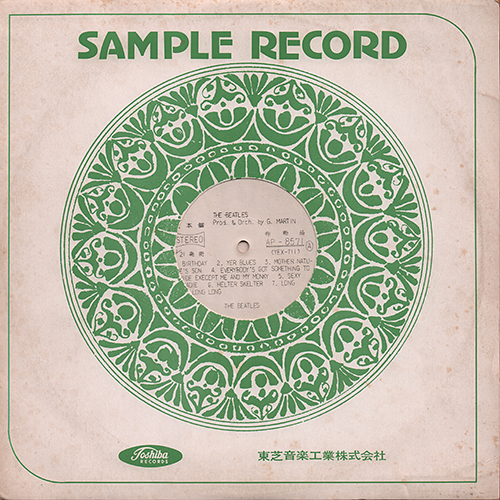 |
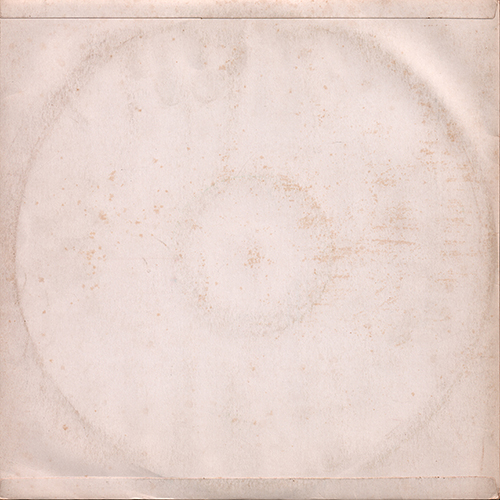 |
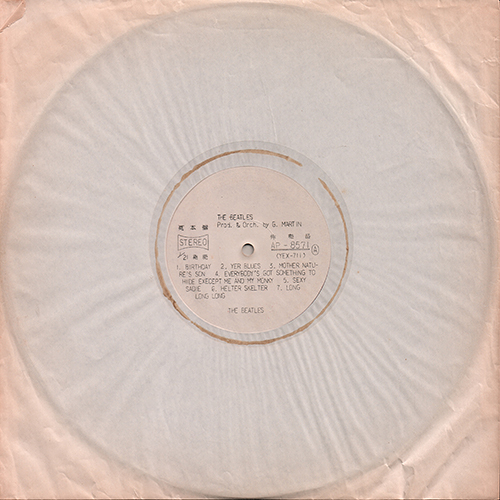 |
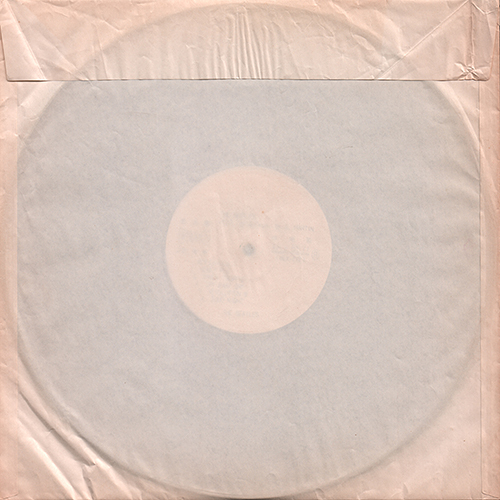 |
Each record was placed in a Toshiba sample sleeve and distributed to radio stations. | |
| LABEL |
DISC | ||||
| DISC 1 |
DISC 2 |
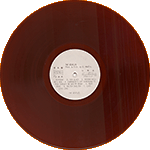 |
|||
| SIDE 1 --> Click! | SIDE 2 --> Click! | SIDE 3 --> Click! | SIDE 4 --> Click! | ||
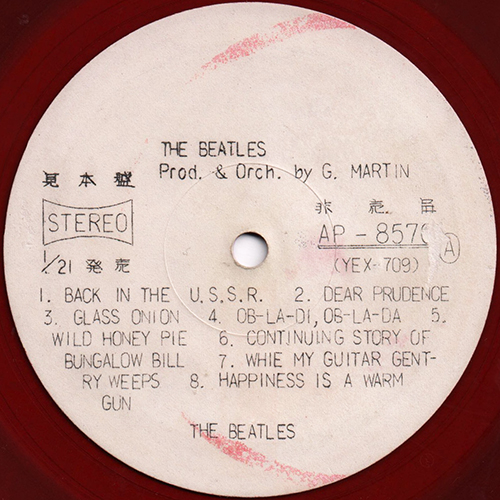 |
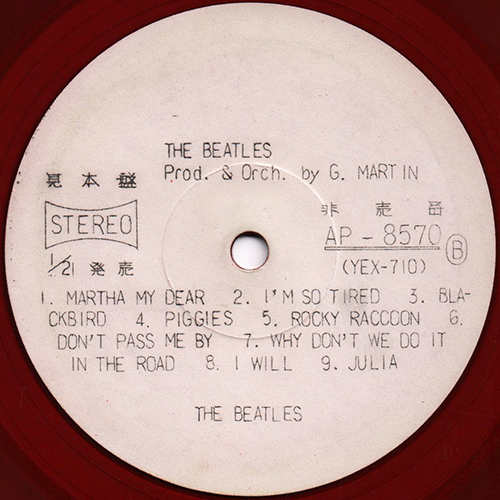 |
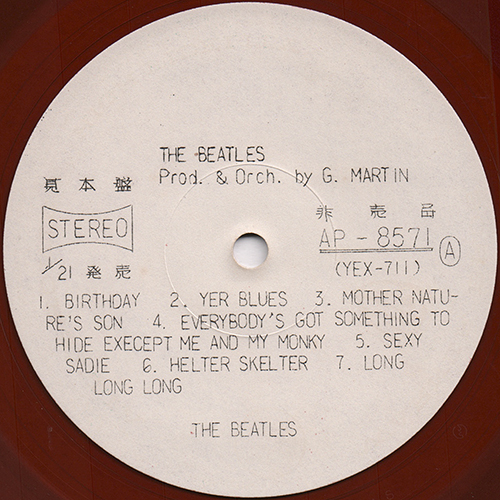 |
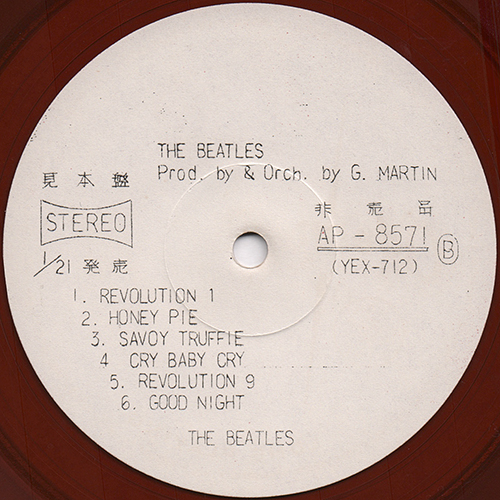 |
||
| ALBUM COVER CLOSE
UP |
|||||
 |
Promo copies were sometimes
sent in generic EMI Sample Record covers. |
||||
| DISC 1: LABEL CLOSE UP | |||||
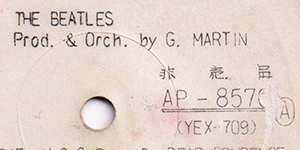 |
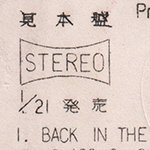 |
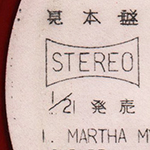 |
The label design of plain white label LPs
(NO Apple logo): The print in black has an unusual
"hand lettered" look to it quite unlike the regular
commercial version. |
||
| DISC 2: LABEL CLOSE UP | |||||
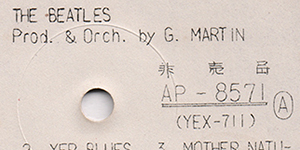 |
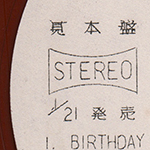 |
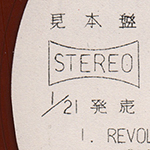 |
Toshiba white label
(promotional use only). The words "Sample" was printed
at upper left side of the label. The release date "21th. January" was printed on both labels. |
||
| DISC1: LABEL CLOSE UP | |||||
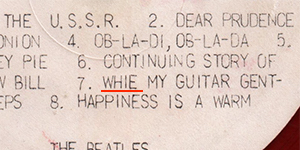 |
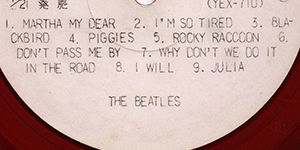 |
Track 7 on side 1 was misspelled as "WHIE MY GUITAR GENTLY WEEPS". | |||
| DISC 2: LABEL CLOSE UP | |||||
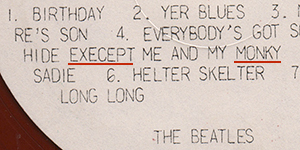 |
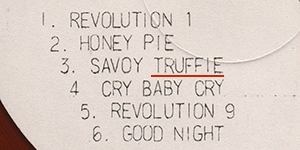 |
Track 4 on side 3 was
misspelled as "EVERYBODY'S GOT SOMETHING TO HIDE EXECEPT ME AND MY MONKY". Track 3 on side 4 was misspelled as "SAVOY TRUFFIE". |
|||
| LABEL CLOSE UP | |||||
| SIDE 1 |
SIDE 2 |
SIDE 3 |
SIDE 4 |
The words "Not For
Sale" was printed at the right side of the label. Catalogue number and matrix number were printed at the below of the catalogue number. |
|
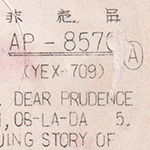 |
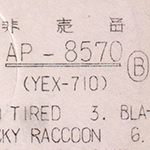 |
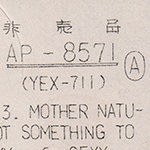 |
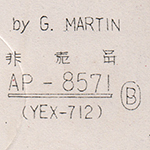 |
||
|
OTHER ITEM
|
|||||
| - | |||||
| RECORD LABEL | Toshiba Plain White Label (for promotional
use only) |
||||
| MIX | STEREO |
||||
| MATRIX No. | SIDE 1 | YEX-709
1S 1 |
|||
| SIDE 2 |
YEX-710
1S 1 |
||||
| SIDE 3 | YEX-711 1S 1 | ||||
| SIDE 4 |
YEX-712
1S2 1 |
||||
| PRESS MARK | DISC 1 |
- |
|||
| DISC 2 | - |
||||
| VINYL COLOR | RED |
||||
| RECORD COMPANY'S NAME | SLEEVE | Toshiba
Ongaku kogyo Kabusikigaisha |
|||
| LABEL | MFD. BY
TOSHIBA MUSICAL INDUSTRIES LTD. JAPAN |
||||
| SYMBOL/PRICE | - |
||||
| LYRIC SHEET STYLE | - |
||||
| COVER FORM | Toshiba Sample Record Sleeve |
||||
| INNER SLEEVE |
The original plain white inner bag has a fold-over flap at the top of the bag to prevent the record from falling out. | ||||
| OBI |
- |
||||
| COVER DESIGN/ PHOTO/ NOTES | Toshiba sample record sleeve. |
||||
|
COMMENTS
|
Toshiba white label
(promotional use only). The Beatles' first double album. The release date was originally announced as 20th. January, but was pushed forward to 18th. January. In Japan, promotional records have traditionally been provided at no charge to radio stations, record shops, and the mass media to increase the sales of a record or in some cases to promote a tour. This type is called the white label promo for which a unique label has been made. The label design of plain white label LPs (NO Apple logo): The print in black has an unusual "hand lettered" look to it quite unlike the regular commercial version. The release date is in black and appears the left of the center hole. Most usually, the regular cover is used with appropriate alterations to prohibit commercial sale. Promo copies were sometimes sent in generic EMI Sample Record covers. |
||||
| TITLE | THE BEATLES |
||||
| CATALOG NUMBER | AP-8570/1 |
||||
| RELEASE DATE | 18th.
January.1969 / First Press |
||||
| TRACK LISTING | SIDE 1 | SIDE 2 | |||
| Back In The U.S.S.R. |
Martha My Dear |
||||
| Dear Prudence |
I'm So Tired |
||||
| Glass Onion |
Blackbird |
||||
| Ob-La-Di, Ob-La-Da |
Piggies |
||||
| Wild Honey Pie |
Rocky Raccoon |
||||
| The Continuing Story Of Bungalow Bill |
Don't Pass Me By |
||||
| While My Guitar Gentry Weeps |
Why Don't We Do
It In The Road |
||||
| Happiness Is A
Warm Gun |
I will |
||||
| Julia |
|||||
| SIDE 3 |
SIDE 4 |
||||
| Birthday |
Revolution 1 |
||||
| Yer Blue |
Honey Pie |
||||
| Mother Nature's
Son |
Savoy Truffie |
||||
| Everybody Got
Something To Hide Except Me And My Monkey |
Cry Baby Cry |
||||
| Sexy Sadie |
(" Can You Take
Me Back...") |
||||
| Helter Skelter |
Revolution 9 |
||||
| Long Long Long |
Good Night |
||||
| FRONT --> Click! | BACK --> Click! | INSIDE --> Click! | DISK | ||
 |
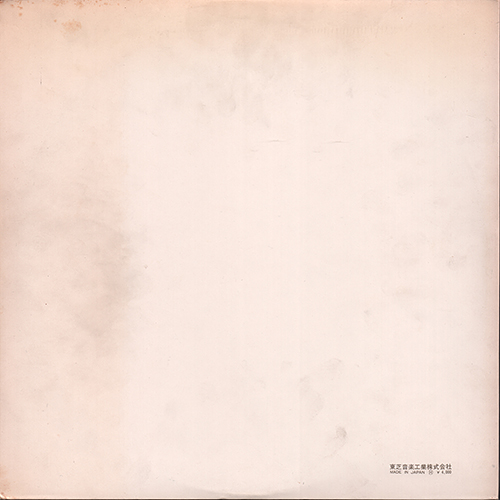 |
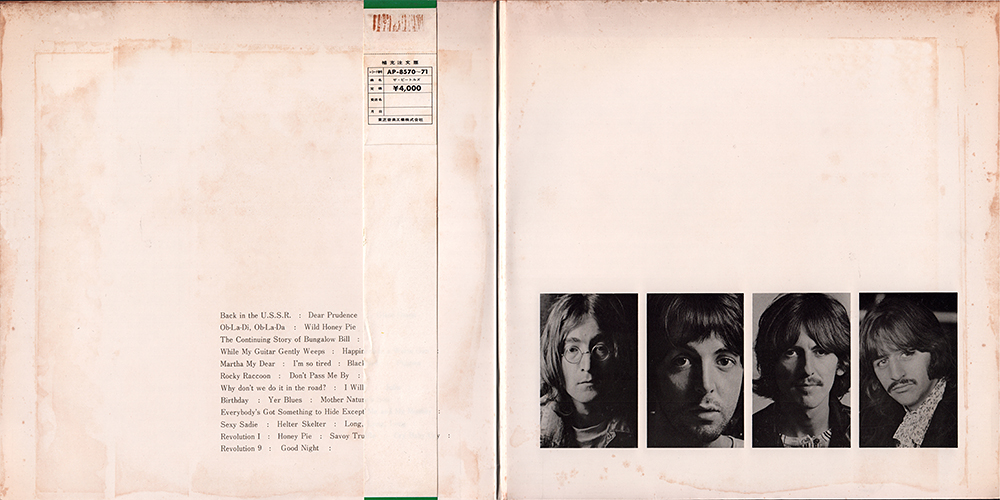 |
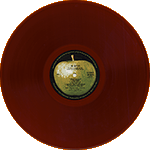 |
||
| LABEL | |||||
| SIDE 1 --> Click! | SIDE 2 --> Click! | SIDE 3 --> Click! | SIDE 4 --> Click! | Dark
green
Apple label Type-1with black print. |
|
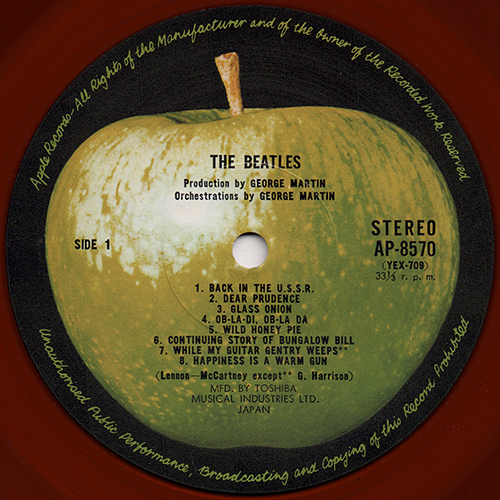 |
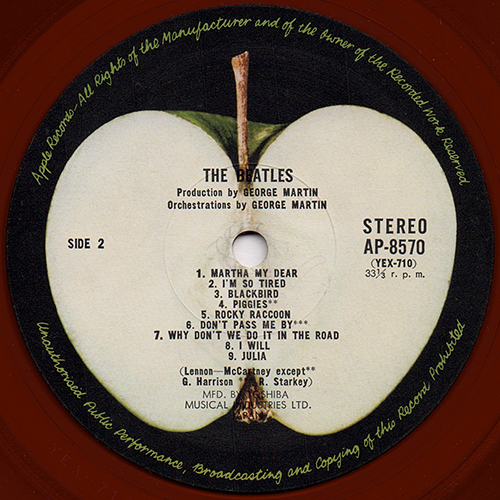 |
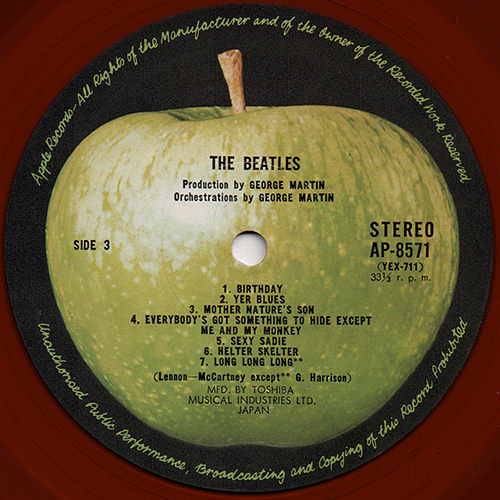 |
 |
||
| INNER SLEEVE |
FRONT COVER CLOSE UP (Serial Number) |
||||
| FRONT --> Click! | BACK --> Click! | ||||
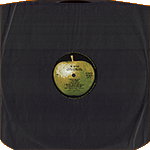 |
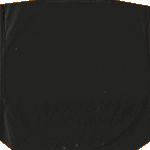 |
 |
With
Apple
custom black inner sleeve. The front cover has “The BEATLES” embossed in raised block letters. Each LP is sequentially numbered. |
||
 |
|||||
| LYRIC
SHEET CLOSE UP |
|||||
 |
"Toshiba Musical Industries Ltd." and "H ¥4,000" was printed at the bottom of the back cover. | ||||
| Apple "Gourd" in dark green OBI CLOSE UP | |||||
| FRONT --> Click! | BACK --> Click! | ||||
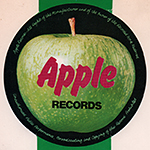 |
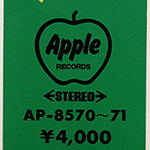 |
Narrow Obi with a large
round Apple logo at the top, has a dark green
background. The Apple logo mark and catalog number were
printed on the front. 1st. pressing had a priced ¥4,000 on
obi strip. |
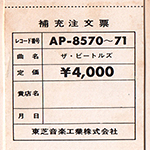 |
The obi remains intactwith
the order form on the back uncut. |
|
| LABEL CLOSE UP | |||||
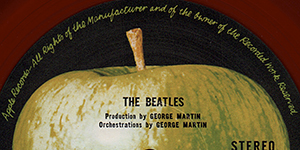 |
Toshiba pressed a lot of their records on
red, "Everclean" vinyl from 1958 through 1974 (maybe).
The Everclean vinyl was designed to be less prone to
collecting static electricity and dust than the more common
black vinyl. In 1969, Toshiba had to reissue on the Apple label all the records previously issued on the Odeon label.The phrase "Apple Records - All Rights of the Manufacturer and of the Owner of the Recorded work Reserved." was printed at the perimeter. |
||||
| LABEL CLOSE UP | |||||
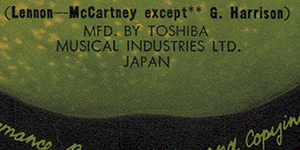 |
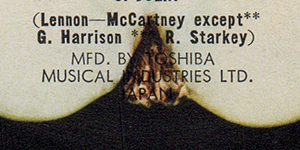 |
The words "MFD. BY TOSHIBA MUSICAL INDUSTRIES LTD. JAPAN" was printed at the bottom of the label. | |||
| LABEL CLOSE UP | |||||
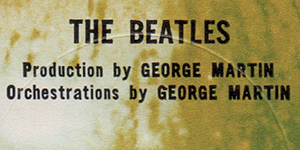 |
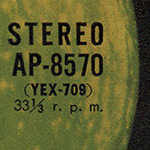 |
"Pro duction
by GEORGE MARTIN" and "Orchestrations by GEORGE MARTIN"
credits were printed at the below of the group's name on the
label. Catalogue number and matrix number were printed at the below of the catalogue number. |
|||
| LABEL CLOSE UP | |||||
 |
 |
2 songs were misspelled as "WHILE MY GUITAR GENTRY WEEPS" and "SAVOY TRUFFIE". | |||
|
OTHER ITEM
|
|||||
| PORTRAITS | |||||
 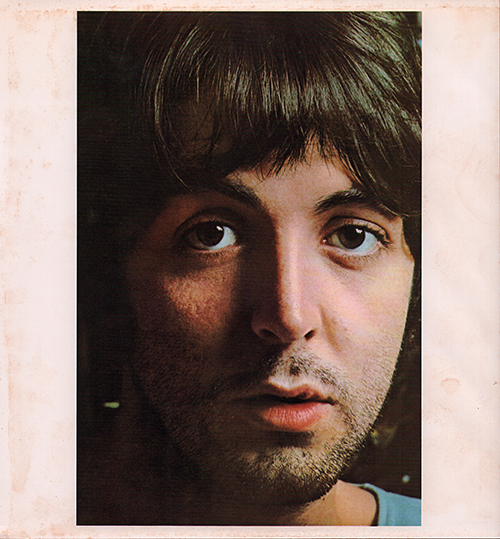 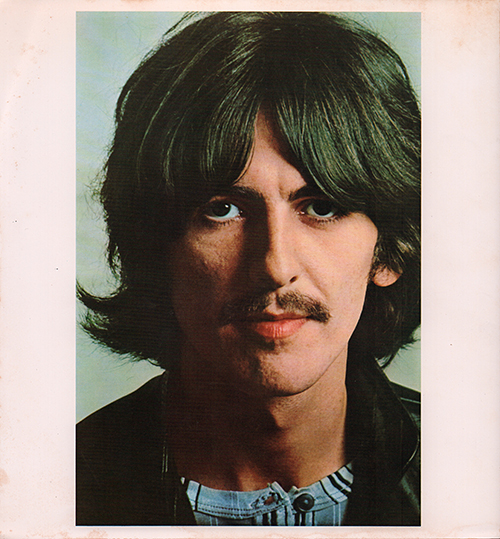 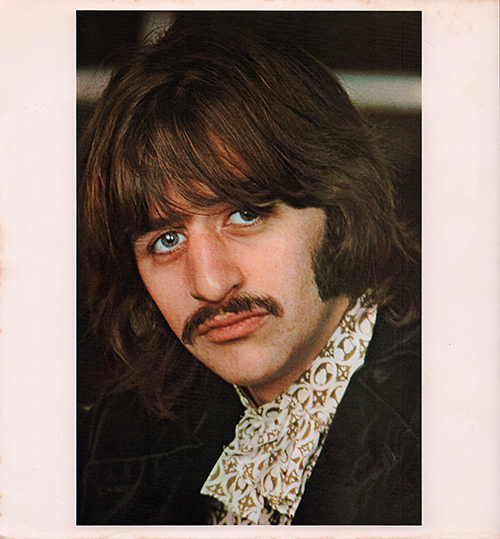 |
Each LP was issued with
four 28.5×27 cm glossy photos of each Beatle taken by John
Kelly. |
||||
| POSTER | |||||
| FRONT --> Click! | BACK --> Click! | POSTER: BACK CLOSE UP |
|||
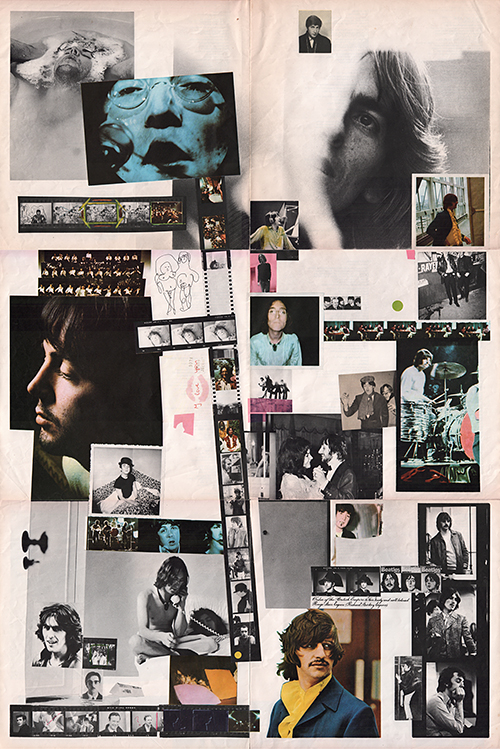 |
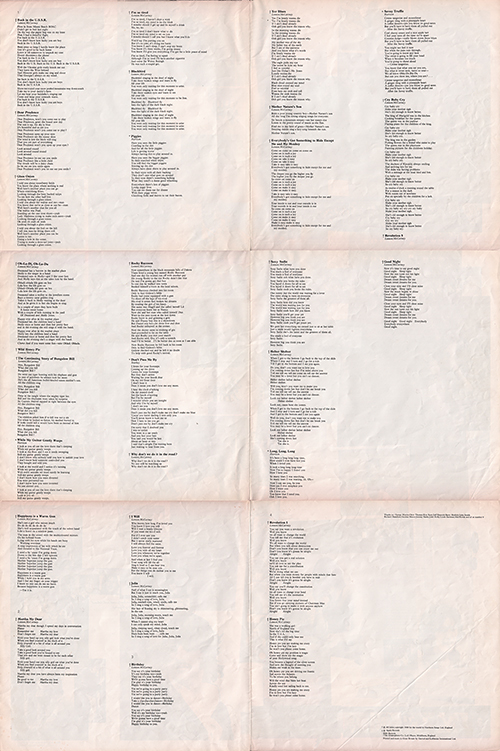 |
 |
|||
| The
sleeve design was by Richard Hamilton, who suggested the
minimalistic approach and the consecutively numbered sleeves
which would give a limited edition feel to it. Richard also
came up with the montage idea for the large free poster,
which included the lyrics on it's rear. Each LP was issued with large 85.8 x57.2 cm poster. The credit "TOSHIBA MUSICAL INDUSTRIES LTD" was printed at the back of the poster. |
|||||
| TRACK
LIST SHEET |
|||||
| FRONT --> Click! | BACK --> Click! | With
a
track list sheet. |
|||
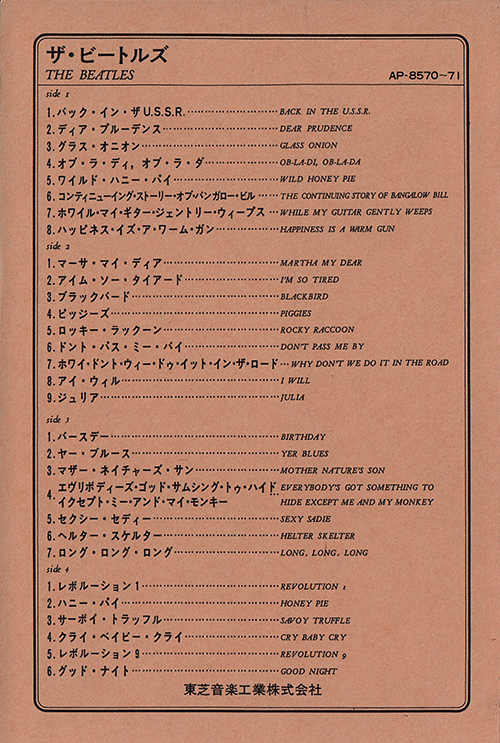 |
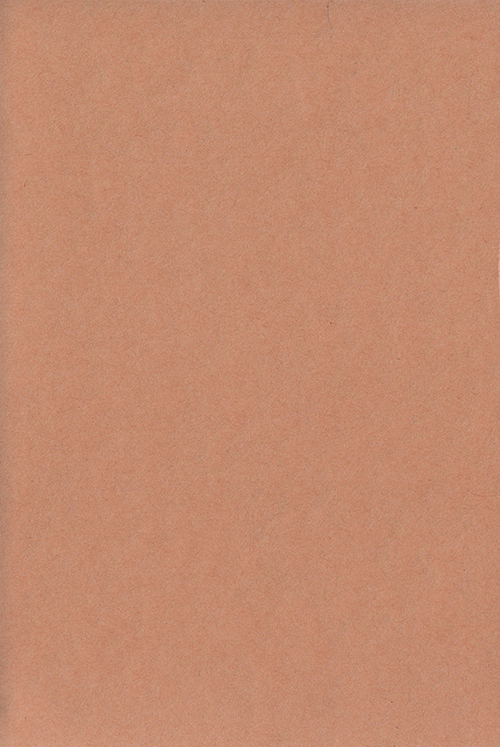 |
||||
| BOOKING SPECIAL GIFT | |||||
| ENVELOPE: FRONT |
ENVELOPE: BACK |
PORTRAIT |
CLOSE UP |
Early
booking
special gifts for pre-order customers. The portrait was inserted in the envelope. |
|
 |
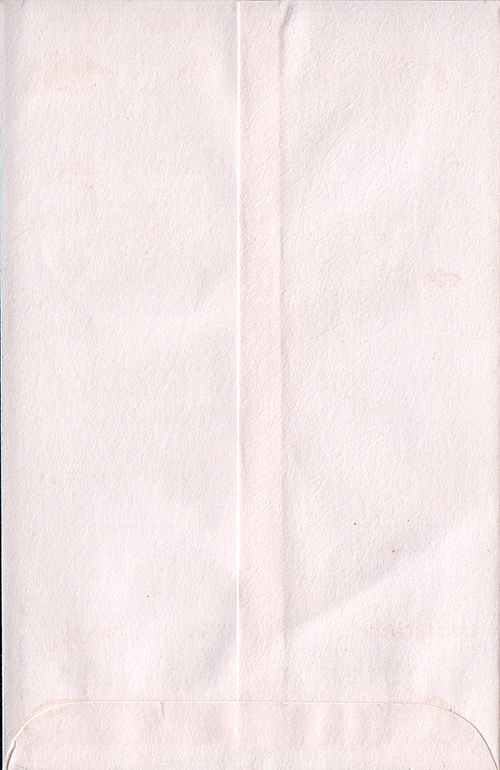 |
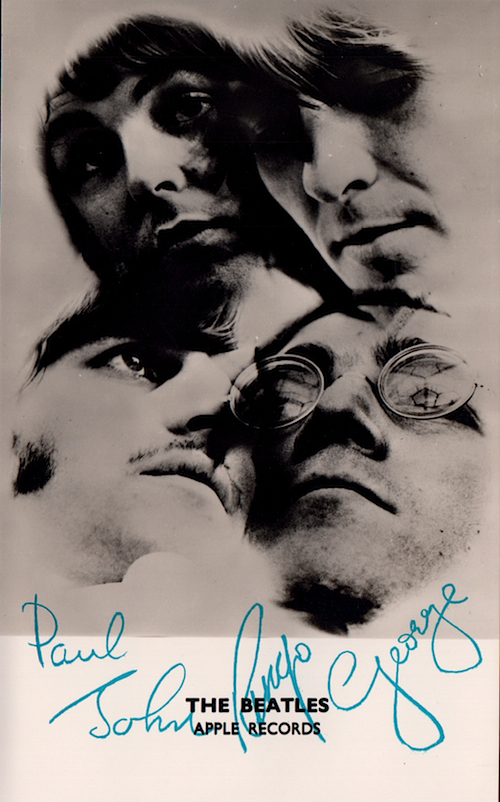 |
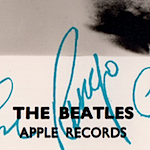 |
||
| FLYER
FOR PRE-ORDER CAMPAIGN |
|||||
| FLYER: FRONT | FLYER: BACK |
FLYER: FRONT CLOSE UP |
|||
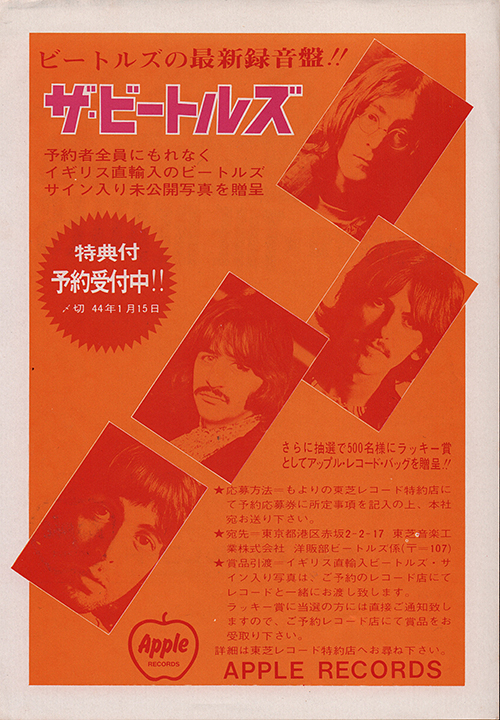 |
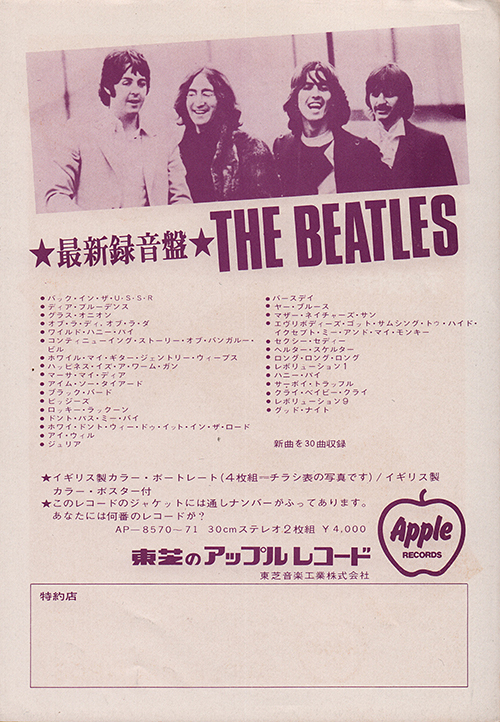 |
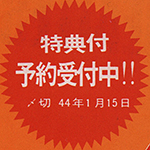 |
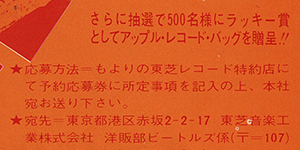 |
||
| FLYER: BACK CLOSE UP | |||||
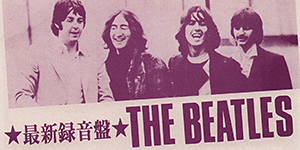 |
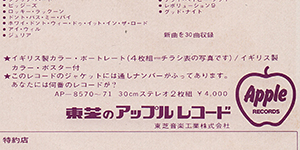 |
Toshiba had special gifts
for pre-order customers. |
|||
| SHOP DISPLAY FOR PRE-ORDER CAMPAIGN | |||||
| DISPLAY: FRONT | SHOP DISPLAY: CLOSE UP |
||||
 |
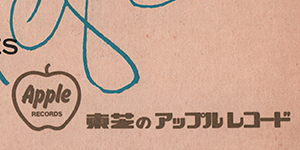 |
This point of
sale display advertises the Beatles first album on Apple
Records in Japan, “The Beatles,” released January, 1969. The
cardboard display measures 27 x 24.5 cm” This display was delivered to record stores by Toshiba as part of a national pre-order campaign. |
|||
| - | |||||
| RECORD LABEL | Dark Green Apple label Type-1 |
||||
| MIX | STEREO |
||||
| MATRIX No. | SIDE 1 | YEX-709 1S2 1
2 |
|||
| SIDE 2 | YEX-710
1S 13 |
||||
| SIDE
3 |
YEX-711
1S
15 |
||||
| SIDE
4 |
YEX-712
1S2
12 |
||||
| PRESS MARK | DISC 1 | 8M |
|||
| DISC 2 |
8M -> A9 | ||||
| VINYL COLOR | RED |
||||
| RECORD COMPANY'S NAME | SLEEVE | Toshiba
Ongaku kogyo Kabusikigaisha |
|||
| LABEL | MFD. BY
TOSHIBA MUSICAL INDUSTRIES LTD. JAPAN |
||||
| SYMBOL/PRICE | H - ¥4,000 |
||||
| LYRIC SHEET STYLE | Slip Sheet Type |
||||
| COVER FORM | Gatefold type. Open Side cover. |
||||
| INNER SLEEVE |
Apple custom black sleeve |
||||
| OBI |
Apple "Gourd" in dark green Obi |
||||
| COVER DESIGN/ PHOTO/ NOTES | Photo: Iain Macmillan |
||||
|
COMMENTS
|
Gatefold and open
side cover. A two-LP set. Comes with four photos and a poster (like U.K. and U.S. versions). Dark green Apple label Type-1with black print. "Pro duction by GEORGE MARTIN" and "Orchestrations by GEORGE MARTIN" credits were printed at the below of the group's name on the label. The words "MFD. BY TOSHIBA MUSICAL INDUSTRIES LTD. JAPAN" was printed at the bottom on the label. The front cover has “The BEATLES” embossed in raised block letters. Each LP is sequentially numbered. Toshiba had special gifts for pre-order customers. The release date of the white album in Japan was originally planned to be 21th. January, but it was rushed to 18th. January. In Novemver 1968, that was the date when Apple Corp Ltd. of England and Toshiba came to an agreement on the manufacturing and distribution of the Beatles' records in Japan. As part of that agreement, Toshiba had to reissue on the Apple label all the records previously issued on the Odeon label. The sleeves also had to be altered to desplay the Apple logo. Futher still, all the Odeon catalog number prefixes were changed to ones with Apple prefixes. In most cases, only the prefixes were changed and the catalog numbers were left intanct. Odeon singles, EPs, and LPs with the OR or OP prefixes were changed to Apple singles, EPs, and LPs with the AR or AP prefixes, respectively. But Toshiba did not instantly implement all these changes and did not immediately withdraw all Odeon label records. In fact, the phasing out of the Odeon label products and the phasing in of the Apple label was a lengthy process taking several months at least. The very first record in Japan issued under the Toshiba/Apple contract and bearing the Apple label was "The Beatles double LP (the White Album)", released on 21th. January 1969. And unlike elsewhere in the world, the first single in Japan to bear the Apple label was not "Hey Jude / Revolution" but rather "Ob- La-Di, Ob-La-Da / While My Guitar Gently Weeps", released on 10th. March, 1969. Red vinyl: Besides good sound and quality printing, Japanese records also offered some other things of interest to the collector. One of the primary manufacturing companies in Japan, Toshiba, pressed a lot of their records on red, “Everclean” vinyl from 1958 through 1974 (maybe). While not pressed as collectors’ items, these red vinyl pressings are more sought out by collectors than their black vinyl counterparts. The Everclean vinyl was designed to be less prone to collecting static electricity and dust than the more common black vinyl. The obi: Apple "Gourd" in dark green Obi 1st. pressing issued with a narrow Obi with a large round Apple logo at the top, has a dark green background. The word "STEREO" and Apple logo mark and catalog number "AP-8570-71" were printed on the front. 1st. pressing had a priced ¥4,000 on rear sleeve and obi strip. While most Japanese records feature local music, a lot of music fans there like foreign music, as well. The language barrier in Japan presented a problem – should foreign album covers be changed for Japanese albums? The solution was the obi, which means “belt” or “sash”. The obi is a strip of paper, usually about two inches wide, that wraps vertically around the album cover, containing information about the artist and album in Japanese. As these strips of paper were fragile and easily torn, they are often missing, especially since consumers in the 1950s and 1960s attached little significance to them. Finding Japanese records made prior to 1970 that still have the obi intact can be quite difficult, and for some albums, nearly impossible. The inclusion of the obi can dramatically affect the price of some Japanese records, sometimes increasing the price by a factor of ten. |
||||
